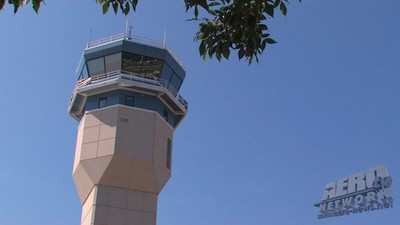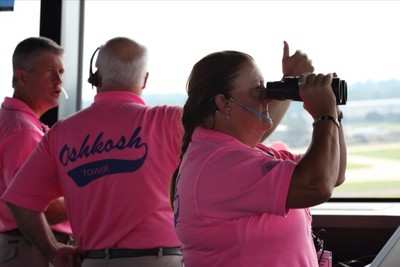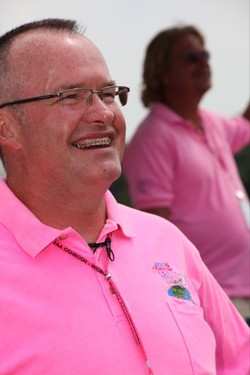A Visit To The Control Tower Cab, Fisk, And A MOOCOW
By Robbie Culver
It's no secret that for one week each year, Wittman Regional
Airport in Oshkosh, WI, transforms from a quiet Class Delta
airspace to one of the busiest airports in the world. Sorting out
all the traffic that arrives, departs, or flies by Oshkosh falls to
the dedicated air traffic controllers from across America who bid
to work at AirVenture Oshkosh.

In 2009, operations at AirVenture on two separate days exceeded
in 10 hours what Chicago O'Hare and Atlanta recorded in 24 hours.
On Friday July 31, 2009, Airventure Oshkosh recorded 3554
operations, while O'Hare recorded 2425 and Atlanta recorded 2710
that same day. The sign stating "World's Busiest Control Tower"
earned its keep.
The FAA's Elizabeth Cory, Deputy of Public Affairs for the
Communication department, and Wanda Adelman, Air Traffic Manager
for the Milwaukee ATCT, provided media representatives a tour of
each facility used at Airventure, and a thorough explanation of not
only the safety procedures in place, but the unique and often very
specific procedures used at Oshkosh. The tour began at the base of
the control tower on the Airventure grounds, where we were briefed
on the required protocols of visitng the world's busiest control
tower. No cell phones, no flash photography, and no getting in the
way of the controllers.
After each media representative
presented a photo ID, we were escorted up to the tower cab without
fanfare. Arriving in the cab, the orderly chaos was apparent
immediately. Runway 27 was in use on the north side of the field,
while runway 18 was in use on the south side. The two runways are
essentially handled as separate airports, while the helicopter
operations from Pioneer airport and the ultralight operations near
the south 40 operate without positive control within very specific
airspace limits.
Shortly before our arrival, the wind had forced a switch from
runway 36 to runway 18, and the traffic flow had to be adjusted
accordingly. Two teams of controllers in the tower worked in
separate areas, in proximity to the runway under their control. The
constant flow of conversation from controller to pilot, and between
the two teams, kept the tower cab at a low level of volume that
felt hushed yet controlled. It was an electrifying environment to
visit, and the energy of the controllers was obvious.

The controllers that work Oshkosh refer
to the experience as the "Super Bowl" of their profession. No other
event or airport will present such challenging, unique, and intense
activity as AirVenture. The FAA assigns 68 Air Traffic Controllers,
13 Supervisors, and 2 Operations Managers to Oshkosh, from 44
facilities across the United States. This year, 175 controllers bid
for the 68 available positions. To state that the controllers
working Oshkosh are the best of the best is an understatement -
these folks are incredible!
The physical facilities include the
airport control tower, MOOCOW's for each runway (more on that
later), and the Fisk approach control facility. Controllers work in
teams of four, and rotate through each position during
Airventure.
Each team has an Oshkosh veteran assigned as team leader. These
controllers must have at least three years of Airventure
experience. At least one team member will have one to two years of
Oshkosh experience, referred to as the Limited category, and one
final team member is an Oshkosh rookie, but even a rookie is a
seasoned controller at their home facility. These teams remain
intact during the rotations through various facilities at
Airventure. Each team has two spotters, using binoculars to
visually scan for conflicting traffic, aircraft problems or
emergencies, and to ensure the traffic flows are safely separated
between the various operational areas.

A waiver allows separation to be reduced and while communication
between the facilities is used as needed, typically the only time
this occurs is when an aircraft has a unique requirement, an
emergency, or when a special event or aircraft operation requires a
procedural change.
Our tour continued as we left the tower cab, and drove out to
the Fisk Approach Control facility. And I'll take you along, and
explain about MOOCOWs, in another report.
 ANN's Daily Aero-Term (05.05.24): Omnidirectional Approach Lighting System
ANN's Daily Aero-Term (05.05.24): Omnidirectional Approach Lighting System Aero-News: Quote of the Day (05.05.24)
Aero-News: Quote of the Day (05.05.24) Airborne 05.06.24: Gone West-Dick Rutan, ICON BK Update, SpaceX EVA Suit
Airborne 05.06.24: Gone West-Dick Rutan, ICON BK Update, SpaceX EVA Suit Airborne 05.03.24: Advanced Powerplant Solutions, PRA Runway Woes, Drone Racing
Airborne 05.03.24: Advanced Powerplant Solutions, PRA Runway Woes, Drone Racing Aero-News: Quote of the Day (05.06xx.24)
Aero-News: Quote of the Day (05.06xx.24)





